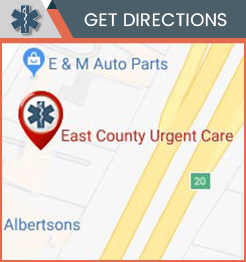Migraine & Headache Treatment Urgent Care in El Cajon, CA
If you are experiencing frequent headaches that interfere with your ability to function or your quality of life, you should talk to a health care provider like East County Urgent Care and Walk-In Clinic of El Cajon, CA. For more information, contact us. We are conveniently located at 1625 E. Main Street # 100 El Cajon, CA 92021.


Table of Contents:
Am I experiencing a headache or a migraine?
How can I prevent migraines?
What treatments are available for headaches?
Headaches are pain that happens in the head, face, or upper neck. They can vary in intensity and frequency. A migraine is a type of painful primary headache disorder. Migraines produce symptoms that can be more intense than headaches. There are types of migraines that do not cause pain, however.
Headaches can come in many different types, but they generally fall into two categories, primary and secondary. Primary headaches indicate independent conditions that cause pain. Primary headaches can be migraines or tension headaches. Secondary headaches happen as a result of another medical condition.
A migraine is a kind of primary headache disorder. It will usually cause severe pain and other symptoms. People who experience migraines can experience recurring symptoms. these are called attacks or episodes. Headaches are just one symptom of migraines. Migraines can cause intense headaches that may last a short time or up to several days. Migraines normally affect only one side of the head.
There are different types of migraines. These depend on the symptoms. Examples of migraines include:
Migraine without aura – this type of migraine can last from 4 to 72 hours. They cause intense throbbing pain. People who get this type of migraine don’t produce symptoms before the migraine sets in.
Migraine with aura – about one-third of the people who experience migraines will have an aura before the onset of the headache. An aura may not happen before the onset of the headache.
Abdominal migraine – abdominal migraines normally affect children between 3 and 10 years of age. Abdominal migraines cause pain in the abdomen, nausea and vomiting. Sometimes this may be accompanied by a headache.
Hemiplegic migraine – this is an uncommon type of migraine. It can cause temporary paralysis. This type of migraine has a range of symptoms that can include: vertigo, vision problems, difficulty speaking or swallowing, trouble moving one side of the body, or stabbing pain in the head.
People who get migraines might notice that certain things can trigger their symptoms. These triggers can vary for each person. Triggers can be environmental or can be triggered by foods. Other triggers can be stress, lack of sleep, depression or anxiety, hormonal changes, alcohol use, or hunger.
There are a few things that may be helpful in preventing migraines. Getting exercise on a regular basis is helpful. Try to find out which foods trigger migraines and eliminate those. Learn relaxation and meditation exercises to reduce stress. It can be helpful to keep a journal and track the patterns of your migraines to uncover triggers. There could be factors that are not listed here that have an impact on you, specifically.
There are currently no cures for migraines or headaches. Medication is available that can help ease the pain and lifestyle changes can prevent future episodes.
Over-the-counter medications can work for headaches, these include:
Pain relievers, like acetaminophen, and non-steroidal anti-inflammatory medications, like aspirin and ibuprofen.
Melatonin has been shown to help prevent some migraines and cluster headaches.
Moderate to severe migraines do not always respond to over-the-counter medications. When these have failed, prescription medications may be a better choice. These can include:
– Anti-nausea medications
– Triptans, such as almotriptan, sumatriptan/naproxen
– Ergot alkaloids, like ergotamine
There are also medications that can be prescribed to prevent future migraines. These medications include:
– Antidepressants
– Anti-seizure medications
– Botox injections
If you are taking an over-the-counter medication or a prescription medication to treat headaches and migraines, you should follow the doctor’s or manufacturer’s recommendations. Overuse of these can cause people to develop medication-overuse headaches.
You should also consider seeking medical help if you are experiencing any of the following symptoms:
– Vomiting
– Nausea
– Vision problems
– Difficulty speaking or understanding what you are hearing
– Tingling, numbness in the face, neck, head, or limbs
– Difficulty thinking
– Difficulty moving one side of your body.
These can indicate that the situation is serious. We serve patients from El Cajon CA, Wells Park CA, Hillsdale CA, Alpine CA, Rancho San Diego CA, Santee CA, and Jamul CA.

Additional Services You May Need
▸Family Practice
▸Employers Services
▸Low Back Pain Treatment
▸PFT & Qualitative Fit Testing
▸Diabetes Treatment
▸Cough Treatment
▸Pediatric Urgent Care El Cajon
▸Pediatric Clinic
▸DOT Physical Exam
▸Sports Physicals
▸Cold & Flu Treatments
▸Lacerations & Burn Treatments
▸Upper Respiratory Treatments
▸Fractures & Sprains Treatments
▸Confidential STD Testing
▸TB Services
▸COVID-19 Testing




